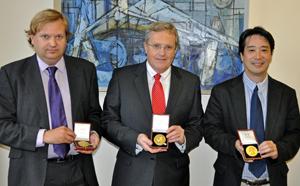
Submitted by Administrator on Thu, 09/12/2010 - 10:11
Congratulations to Professor Kenichi Soga, Dr. Campbell Middleton and Paul Fidler, who together with Professor Neil Hoult and Dr. Peter Bennett (both formerly of the Department) and 3 collaborators at Imperial College, have been awarded the 2010 Telford Gold Medal by the Institution of Civil Engineers for their paper "Wireless sensor networks: creating 'smart infrastructure'". The Telford Medal is the ICE's highest award for a paper and is awarded for an outstanding paper believed to be of the highest practical value to the profession.
One of the greatest challenges facing civil engineers in the 21st century is the stewardship of ageing infrastructure. Much of the world’s civil infrastructure suffers from significant levels of deterioration but there is insufficient funding available to refurbish or replace components that are deemed to be inadequate. Nowhere is this more apparent than in the networks of tunnels, pipelines and bridges that lie beneath and above the major cities around the world. Much of this infrastructure was constructed more than half a century ago and there is widespread evidence of its deterioration. Tunnels, particularly old ones, are prone to being influenced by activities such as adjacent construction, for instance piling, deep excavations and other tunnel construction. Excessive leakage and pipe bursts are frequent and usually unanticipated. Importantly, underground structures often cannot be inspected when they are being used by trains or due to other physical constraints. Bridges are susceptible to corrosion from de-icing salts and subject to ever increasing demands as the legal weight limit of lorries has been progressively increased over the years. Vehicular impacts and scour to the foundations of both road and rail bridges have resulted in significant loss of life and major disruption to strategic supply and distribution links. Little is known of the long-term performance of such infrastructure. These uncertainties and the importance of safety to users and consumers prompted the initiation of this research project investigating the prospect of damage detection and decision making and the use of novel sensors to mitigate damage.
Management programmes are required to optimise and prioritise available resources by establishing which structures are in adequate condition, which require maintenance and which need replacement. This is a significant challenge, particularly as data about the present condition and performance of many assets are not available.
One way to acquire data about structural performance is to install a monitoring system. Conventional monitoring systems employ a series of sensors connected together using wires to transfer the data and supply the power. These sensors are then connected to a data logger which stores the data and allows the user to access it either remotely or on site. The sensors, cabling and installation for a conventional monitoring system can represent a large capital expenditure, especially for a system with many sensors. Given the limited funds available for maintenance and replacement of infrastructure, managers would prefer to spend the bulk of the available money on the infrastructure itself rather than on monitoring systems.
As part of an Engineering and Physical Sciences Research Council (EPSRC)-funded research project, the team of researchers are investigating the use of wireless sensor networks to see if they can offer an effective and economic alternative to conventional monitoring systems.
This paper reports on the trial installations of wireless sensor networks in a suspension bridge, slab bridge, rail tunnel and water supply pipeline. Each installation is introduced in terms of hardware, measured parameters, sensors, sampling regimes and installation and operational challenges. Preliminary results from each system are discussed to illustrate the variety of information that can be made available to managers and engineers, and how this information can be utilised and presented.
The paper can be found here: "Wireless sensor networks: creating 'smart infrastructure'"
